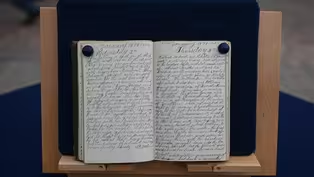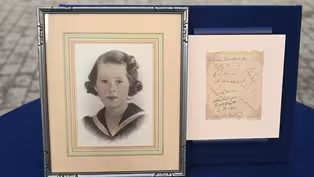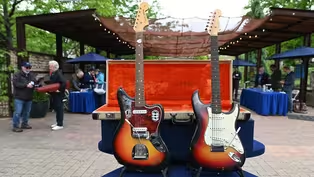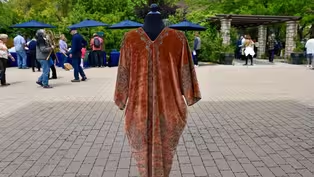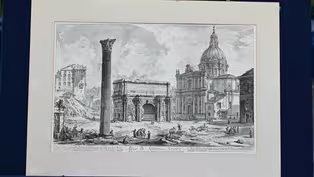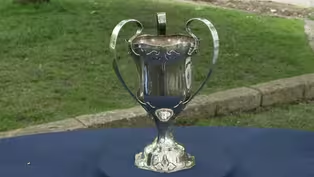
Appraisal: 1830 Northwest Coast Clan Crest Helmet Finial
Clip: Special | 4m 9sVideo has Closed Captions
Appraisal: Northwest Coast Clan Crest Helmet Finial, ca. 1830
Check out Ted Trotta's appraisal of a northwest coast Clan crest helmet finial, ca. 1830, in RECUT: Idaho Botanical Garden, Part 2.
Problems playing video? | Closed Captioning Feedback
Problems playing video? | Closed Captioning Feedback
Funding for ANTIQUES ROADSHOW is provided by Ancestry and American Cruise Lines. Additional funding is provided by public television viewers.

Appraisal: 1830 Northwest Coast Clan Crest Helmet Finial
Clip: Special | 4m 9sVideo has Closed Captions
Check out Ted Trotta's appraisal of a northwest coast Clan crest helmet finial, ca. 1830, in RECUT: Idaho Botanical Garden, Part 2.
Problems playing video? | Closed Captioning Feedback
How to Watch Antiques Roadshow
Antiques Roadshow is available to stream on pbs.org and the free PBS App, available on iPhone, Apple TV, Android TV, Android smartphones, Amazon Fire TV, Amazon Fire Tablet, Roku, Samsung Smart TV, and Vizio.
Buy Now
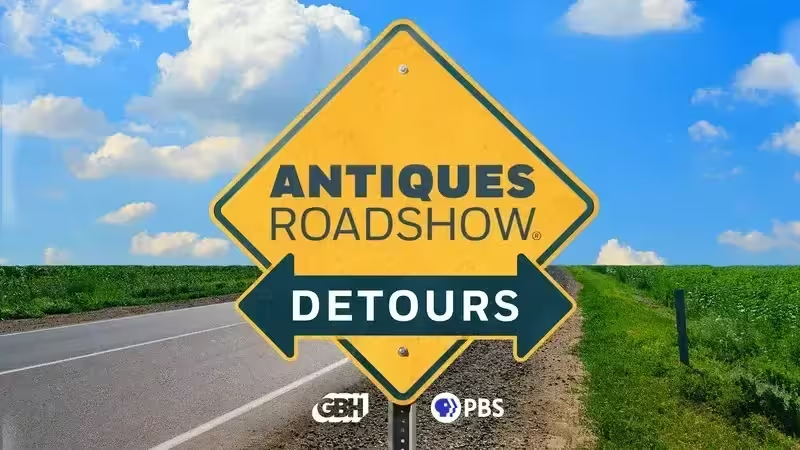
ANTIQUES ROADSHOW DETOURS
Ever wondered what happens to the treasures featured on America’s beloved ANTIQUES ROADSHOW after the cameras leave town? Host Adam Monahan tracks down the juicy afterlives of your favorite finds from PBS’s hit series.Providing Support for PBS.org
Learn Moreabout PBS online sponsorshipGUEST: I had an uncle who was a very fine artist, collected art, and he was a, did restorations of, of art, and he was working on, uh, Hearst, some Hearst paintings.
Phoebe Hearst had a lot of Indian baskets and, and Indian things.
(laughs) APPRAISER: Yeah.
GUEST: He saw Phoebe's collection, and was able to purchase some of the baskets, and this was also included.
Because I liked art, he went ahead and, and did a painting of this... APPRAISER: Yeah.
GUEST: ...and sent me what was the original.
I understand it might have been on a helmet, but it's at least the top part.
APPRAISER: Do you have a feeling for tribal identity?
GUEST: Uh, I think it might be Native Alaskan.
APPRAISER: Okay.
Okay, it's from an area that we would call the Northern Northwest Coast.
And there were three tribes that were particularly remarkable in their cultural architecture, symbolism, artistry, and their cultural life: the Haida, the Tlingit, and the Tsimshian.
I believe this is either Tsimshian or Tlingit, two of the foremost tribes of that area.
And they excelled at carving wood and carving their clan symbols in wood in ceremonial regalia.
So, you're correct, this is the finial to a clan crest helmet.
And these clan crest helmets indicated who the individual was that was wearing it and what their lineage was.
So if you were a member of the Orca clan or the Bear clan, everybody that's o, observed this would immediately know.
And it would have been a man, in this case.
GUEST: Okay.
APPRAISER: And he would have been, uh, someone of high regard.
I believe the top of the finial represents the fin of a killer whale or an orca.
GUEST: Oh.
APPRAISER: The eye of the figure is humanoid.
The nostrils is, appear to be very, very ferocious.
They're expanded.
They're in almost an attack posture.
GUEST: Mm-hmm.
APPRAISER: So there's a tremendous amount of energy being demonstrated there.
And then the lips are bared, the teeth are shown.
This would represent perhaps a warrior.
At the back, there are all of these little holes.
These would have contained tufts of human hair.
GUEST: Wow.
APPRAISER: And they would have been maybe three or four inches long.
And if this individual was standing in the wind, they would move.
If he was dancing, they would move.
They're pegged in with pieces of wood.
Do you have a feeling for the age here?
GUEST: Based on the other collection that my uncle bought from Phoebe Hearst, um, somewhere between 1890 and perhaps the first part of the last century.
APPRAISER: I, I think the Hearsts were collecting their baskets at just that period that you suggest.
And that's the height of the basketry market in, uh, from California all the way up to the coast.
This is older than that.
GUEST: Really?
APPRAISER: (clears throat): This may be as old as circa 1830.
GUEST: Wow.
APPRAISER: This, this is very old.
GUEST: I'm surprised.
(laughs) APPRAISER: Um, the sculptural quality is ex, superb.
The colors are great, they're rich.
The red reflects a vital color, of, um, blood, of lifelines.
Also, uh, spiritually associates with the upper powers, the powers of the upper world.
It's probably mercury vermilion, which is a trade, uh, pigment.
The copper green is a color derived from copper, like a copper oxide.
And then the black is a commercial pigment.
GUEST: Hm.
APPRAISER: I'm not sure what its nature was.
GUEST: Mm-hmm.
APPRAISER: This is, uh, as, as refined a sculpture as you're going to find on the coast of British Columbia.
It's just truly supreme.
GUEST: Right.
APPRAISER: On a retail basis, I would value this in the neighborhood of $30,000.
GUEST: (laughing): Oh, my God!
APPRAISER: Yeah.
And, and it would, that would be a... That would be a good value.
GUEST: Yes.
APPRAISER: Yeah, it's, it's such a, it's...
GUEST: I had no idea.
APPRAISER: If this was the finial on top of a clan crest helmet, and we had the whole ensemble, we'd be in the neighborhood of perhaps of $150,000.
GUEST: I wasn't going to bring it 'cause I had to have something to fit in my purse.
(laughs)
Appraisal: 1877 - 1878 Lorus Bishop Pratt Journal
Video has Closed Captions
Clip: Special | 3m 45s | Appraisal: 1877 - 1878 Lorus Bishop Pratt Journal (3m 45s)
Appraisal: 1934 All-American Baseball Team Autographs
Video has Closed Captions
Clip: Special | 3m | Appraisal: 1934 All-American Baseball Team Autographs (3m)
Appraisal: 1965 Fender Jaguar & 1964 Stratocaster
Video has Closed Captions
Clip: Special | 3m 46s | Appraisal: 1965 Fender Jaguar & 1964 Stratocaster (3m 46s)
Appraisal: Fortuny Silk Velvet Jacket, ca. 1925
Video has Closed Captions
Clip: Special | 3m 54s | Appraisal: Fortuny Silk Velvet Jacket, ca. 1925 (3m 54s)
Appraisal: Giovanni Battista Piranesi Print, ca. 1800
Video has Closed Captions
Clip: Special | 3m 10s | Appraisal: Giovanni Battista Piranesi Print, ca. 1800 (3m 10s)
Appraisal: Shreve & Co. Sterling Silver Loving Cup, ca. 1910
Video has Closed Captions
Clip: Special | 3m 5s | Appraisal: Shreve & Co. Sterling Silver Loving Cup, ca. 1910 (3m 5s)
Providing Support for PBS.org
Learn Moreabout PBS online sponsorship
- Home and How To

Hit the road in a classic car for a tour through Great Britain with two antiques experts.













Support for PBS provided by:
Funding for ANTIQUES ROADSHOW is provided by Ancestry and American Cruise Lines. Additional funding is provided by public television viewers.


